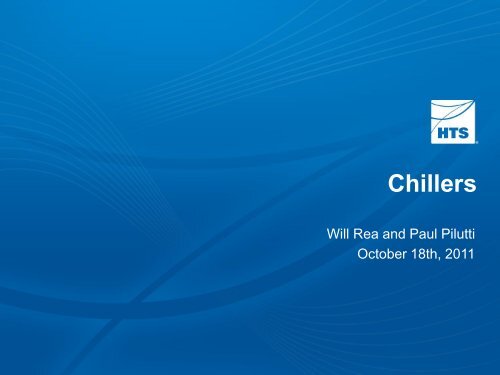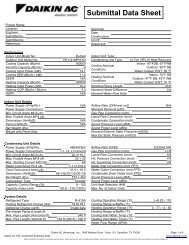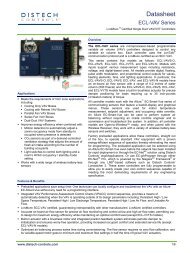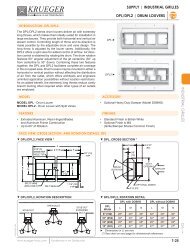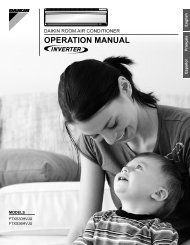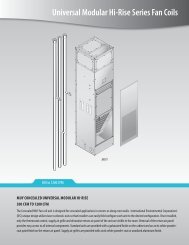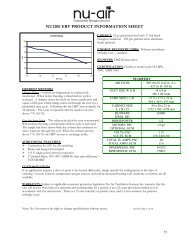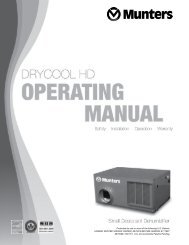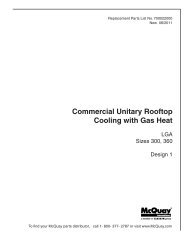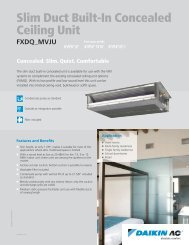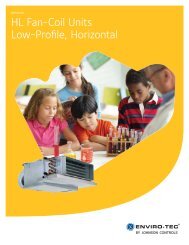Chillers - HTS
Chillers - HTS
Chillers - HTS
You also want an ePaper? Increase the reach of your titles
YUMPU automatically turns print PDFs into web optimized ePapers that Google loves.
<strong>Chillers</strong><br />
Will Rea and Paul Pilutti<br />
October 18th, 2011
Motivation<br />
Why use <strong>Chillers</strong>?<br />
• People don’t like to sweat!<br />
• Efficient heat rejection machine<br />
• Chilled water is simple to use<br />
• Simple to control
Contents<br />
Fundamentals<br />
Vapour-Compression<br />
<strong>Chillers</strong><br />
Technology<br />
Heat Exchangers<br />
Refrigerants<br />
Compressors<br />
Applications<br />
Dual compressor<br />
IPLV/NPLV
Fundamentals
Types of Refrigeration<br />
Vapour Compression<br />
• Refrigerants evaporated and condensed<br />
• 99.9% of chillers<br />
Absorption<br />
• Use excess heat to drive refrigeration cycle<br />
• Selling one will get you fired!
Refrigeration<br />
• Ideal refrigeration is to the right<br />
• 1 Cold Gas enters the compressor<br />
• 2 Hot gas leaves compressor<br />
• 3 Hot gas is condensed into a liquid<br />
• 4 Pressure is reduced<br />
causing a liquid begin to evaporate<br />
4<br />
3<br />
1<br />
2
<strong>Chillers</strong><br />
Chiller Basics<br />
• Make cold water by removing heat<br />
• Reject heat to water loop, or ambient air<br />
• Scroll, Screw and Centrifugal compressors<br />
• Constant/Variable Speed<br />
• Ball, Oil, or Magnetic Bearing<br />
• Efficiency rated on weighted average
Air Cooled<br />
Advantages<br />
• Packaged product – no cooling tower<br />
• Can have integral pumps and airside economizer<br />
• As small as 3 Tons<br />
Disadvantages<br />
• Inefficient compared to water cooled (average 0.85 kW/Ton)<br />
• Noise/architectual concerns<br />
• Not custom designed<br />
• Limited to about 550 tons
Water Cooled<br />
Advantages<br />
• Very efficient (average
Oil<br />
Great Lubricator<br />
• Used to lubricate moving components<br />
• Oil is miscible in refrigerant<br />
• Proper refrigerant velocity is crucial to maintaining oil balance<br />
Great Insulator<br />
• Causes a 1-3% reduction in performance at startup<br />
• Can reduce efficiency by up to 20% in an older machine<br />
• Chiller and VRV have sophisticated oil management
Refrigerants<br />
Chiller Refrigerants<br />
• Most common R-11,12, 123, 134a, 410a<br />
• R410a used for scroll low temp machines<br />
• R-134a used for screw/centrif and high temp machines<br />
Ontario R-11 Phase-out (Reg. 463/10)<br />
• R-11 operation banned January 1 2012<br />
• R-11 becomes hazardous waste July 1 2012<br />
• Hundreds of machines left in GTA alone<br />
• Dave Ross, Ministry Of Enviornment
Positive vs. Negative Pressure<br />
Positive Pressure – York, McQuay, Carrier<br />
• Refrigerant circuit is always a higher pressure than the ambient<br />
• Leaks out rather than in, easy to find a leak<br />
Negative Pressure - Trane<br />
• At some points the refrigerant is a lower than atmospheric pressure<br />
• If a leak develops can suck in contaminants to refrigerant cycle<br />
• Used with R-123, production of new machines banned after 2020,<br />
production of refrigerant banned after 2030, 19 years away
Efficiency Ratings<br />
• All of them are an expansion of energy used per BTU of refrigeration<br />
• EER, COP, kW/Ton are full load ratings<br />
• IPLV, NPLV, SEER account for part load conditions<br />
Equipment Water cooled Air Cooled<br />
Rating kW/Ton EER<br />
Good Rating 0.6 9.5<br />
Exceptional Rating 0.5 11<br />
Part Load Equivalent IPLV or NPLV IEER<br />
Good Rating 0.45 12<br />
Exceptional Rating 0.3 19
Fundamental Review<br />
• Vapour compresion chillers<br />
• Oil helps lubricates, also helps insulate<br />
• Refrigerants are changing, and being phased out<br />
• Real life refrigeration is not 100% efficient<br />
• IPLV vs. NPLV
Technology
Components<br />
Evaporator<br />
Compressor<br />
Starter/Drive<br />
Refrigerant<br />
Condensor
Condensers/Economizers<br />
Water<br />
• Shell and tube is standard<br />
• Discharge gas rains off the tubes as a liquid<br />
Air<br />
• Airside coil that condenses refrigerant<br />
• Big push for micro channel (car radiator)<br />
Economizer<br />
• Hydronic fin and tube coil<br />
• Begins to work with 2F approach
Evaporator<br />
Brazed Plate<br />
• Cost –effective, great performance<br />
• No availability above 120 Tons<br />
Flooded<br />
• Shell is flooded with refrigerant<br />
• Offers better performance<br />
Direct Expansion<br />
• Refrigerant expanded in tubes<br />
• Low refrigerant volumes
Evaporator – Falling Film<br />
• Try and create flooded effect, with minimal refrigerant<br />
• Coating tubes would create the same effect<br />
• Use a plate to rain refrigerant down<br />
• Can reduce refrigerant charge by 30-50% in a chiller
Starters/Drives<br />
Solid State/Star-Delta<br />
• Reduces inrush current<br />
• Protects compressor<br />
• Can not turn down machine<br />
VFD<br />
• Slowly ramps up frequency<br />
• Allows low inrush current<br />
• Allows impeller to be slowed down
Starters/Drive – Open vs. Hermetic<br />
Open Drive – York/JCI<br />
• Motor is open to the outside<br />
• Contaminants can reach the motor<br />
• Refrigerant seals may fail and cause leaks<br />
• Adds heat to mechanical room<br />
Hermetic – Trane, Carrier, McQuay<br />
• Compressor is completely sealed as part of the refrigeration circuit<br />
• Motor is cooled by refrigerant, no excess heat<br />
• No seals on moving parts
Compressors - Scroll/Screw<br />
Scroll<br />
• Two off-centre scrolls oscillate<br />
• Very robust compressor<br />
• Expect VFD models in the future<br />
Screw<br />
• Contains 1 or 2 interwinding screws<br />
• Screws machines for decreasing volume through machine<br />
• Great for high lift applications (ice making)
Compressors - Scroll
Compressors - Screw
Compressors – Centrifugal<br />
• Uses velocity pressure to compress the refrigerant<br />
• Most efficient, tightest operating envelope<br />
• R-134a machines use a high speed<br />
• Smaller impellers, smaller compressors, gear ratio<br />
• Use variable inlet vanes, diffuser plates, VFDs to unload
Compressors – Magnetic Bearing Centrifugal<br />
• Electromagnets levitate shaft<br />
• Offers exceptional part load efficiency<br />
• Removes oil management system<br />
• IPLV of
Technology Review<br />
• <strong>Chillers</strong> have 5 components<br />
• Refrigerant – constantly changing<br />
• Condensor<br />
• Evaportor – different types, falling film new<br />
• Starters/Drives -<br />
• Compressors -
Application
Dual Compressor<br />
Single Circuit Dual Compressor<br />
• 60% capacity with one compressor running<br />
• Offers excellent part load performance<br />
Dual Circuit Dual Compressor<br />
• Fully independent systems<br />
• Offers full redundancy in a single machine<br />
• Counter flow design offers improved full<br />
load efficiency
Series Counter-Flow<br />
• Used in multi compressor situations<br />
• Compressors in series<br />
• Condenser flows opposite evaporator<br />
• Used for large campus applications<br />
• Reduces lift on both compressors
OEA<br />
• Operating Engineers Act<br />
• Mandates requirements for refrigeration plants<br />
• Positive displacement/Centrifugal<br />
• Based on full load kW hookup<br />
• Medium systems need maintenance schedules<br />
• Large plants require engineers on standby
LEED Credits<br />
• Credit 4 Refrigerant Management<br />
• Credit for Efficiency Management
Aermec<br />
New line by <strong>HTS</strong><br />
• Made in Verona Italy<br />
• Worlds Quietest Fan Coil with NC-25<br />
• Line of chillers and air to water heat pumps from 3-250 tons<br />
• Integral pump and buffer tanks<br />
• Full waterside economizer (free cooling below 30F for 44F water)
Application Review<br />
• Dual Compressor<br />
• Series counterflow<br />
• OEA<br />
• LEED
Questions?<br />
Questions?
Next Time – November 23, 2011<br />
Natatoriums<br />
• Equipment<br />
• Humidity Control<br />
Low Grain Dehumidification<br />
• Equipment<br />
• Liquid vs. Solid Desiccants<br />
• Application


